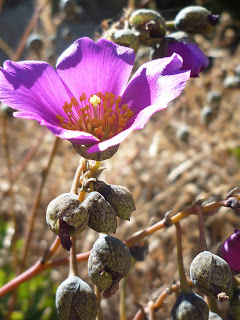
It is not possible to follow the coast all the time when heading south from Santiago, there are patches of road along the coast but at other times the road takes one off through dirt tracks up and down steep hillsides. We are travelling with 5 kids in the back of the car, things are animated to say the least!
The coast itself is dramatic with black volcanic sand, ragged outcrops of rocks forming creeks and violent waves ideal for experienced surfers.

I enjoyed myself getting to know some of the intrepid flowers and plants that grow on the rocks in full exposition of the sea winds. Ionly have the name of one of the following plants so any help is much appreciated.

This plant is very elegant and stuck out from far, it was growing perched high on the cliffs facing the sea, it has a rosette of succelent leaves at it's base and long petiole with a bunch of intense purple flowers at the end of each petiole. The flowers have 5 separate petals, slightly "enchancree", sorry my botany terms are all in French, 1 style and many stamens. The calice is "gammo" but in 2 parts, light green with nearly black lines and a nearly black base to it. The ovary is superieur forming a capsule full of small black akenes.

This is another succulent plant that grows in the rocks with no soil at all. The petiole looks like a minature palm (the plant is very small, no higher than 5 cm's) with browny scales, the leaves are composed of three folioles, similar to that of an oxalis but succulent. The calice is leave-like in three parts flattened against the flower's tube. The yellow flowers are solitary with 5 separate petals and 10 etamines.

This little blue flower was the only one of its type around, growing on the sand itself. It features in the wildlife book I have of Chile , it's name is Nolana paradoxa.

Aucun commentaire:
Enregistrer un commentaire